2020 |
||
| 24. | 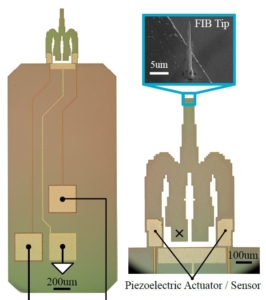 | S. I. Moore; M. G. Ruppert; Y. K. Yong AFM Cantilever Design for Multimode Q Control: Arbitrary Placement of Higher-Order Modes Journal Article In: IEEE/ASME Transactions on Mechatronics, pp. 1-6, 2020, (Early Access). Abstract | Links | BibTeX | Tags: AFM, Cantilever, MEMS, Multifrequency AFM, Smart Structures, SPM, Vibration Control @article{Moore2020,In the fast growing field of multifrequency atomic force microscopy (AFM), the benefits of using higher-order modes has been extensively reported on. However, higher modes of AFM cantilevers are difficult to instrument and Q control is challenging owing to their high frequency nature. At these high frequencies, the latencies in the computations and analog conversions of digital signal processing platforms become significant and limit the effective bandwidth of digital feedback controller implementations. To address this issue, this article presents a novel cantilever design for which the first five modes are placed within a 200 kHz bandwidth. The proposed cantilever is designed using a structural optimization routine. The close spacing and low mechanical bandwidth of the resulting cantilever allows for the implementation of Q controllers for all five modes using a standard FPGA development board for bimodal AFM and imaging on higher-order modes. |
2019 |
||
| 23. | 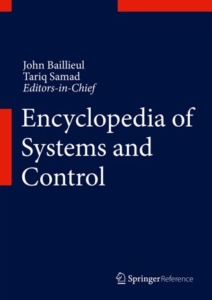 | M. G. Ruppert; S. O. R. Moheimani Dynamics and Control of Active Microcantilevers Book Chapter In: Baillieul, John; Samad, Tariq (Ed.): Encyclopedia of Systems and Control, vol. 2, Springer London, 2019, ISBN: 978-1-4471-5102-9. Abstract | Links | BibTeX | Tags: AFM, Cantilever, MEMS, Multifrequency AFM, Piezoelectric Transducers and Drives, Smart Structures, Vibration Control @inbook{Ruppert2019b,The microcantilever is a key precision mechatronic component of many technologies for characterization and manipulation of matter at the nanoscale, particularly in the atomic force microscope. When a cantilever is operated in a regime that requires the direct excitation and measurement of its resonance frequencies, appropriate instrumentation and control is crucial for high-performance operation. In this entry, we discuss integrated cantilever actuation and present the cantilever transfer function model and its properties. As a result of using these active cantilevers, the ability to control the quality factor in order to manipulate the cantilever tracking bandwidth is demonstrated. |
| 22. | 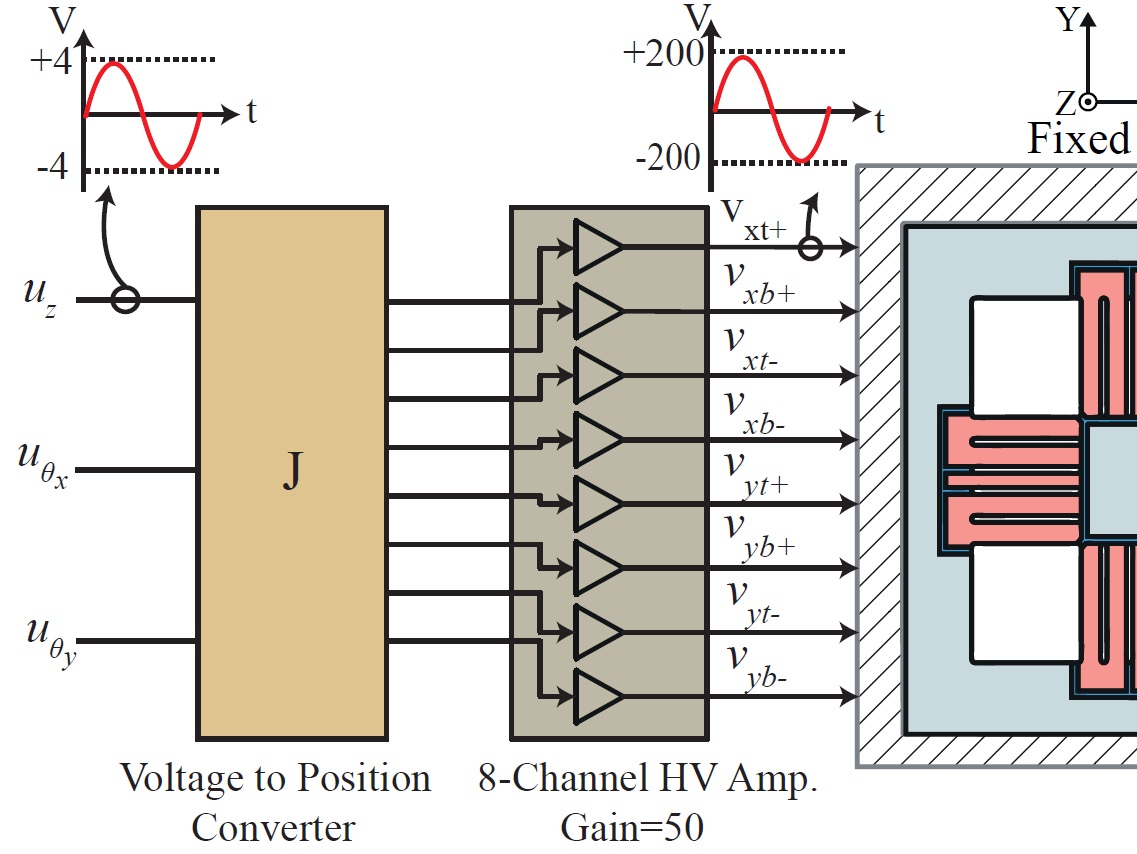 | M. Omidbeike; A. A. Eielsen; Y. K. Yong; A. J. Fleming Multivariable Model-less Feedforward Control of a Monolithic Nanopositioning Stage With FIR Filter Inversion Proceedings Article In: International Conference on Manipulation, Automation and Robotics at Small Scales (MARSS), Helsinki, Finland, 2019, ISSN: 978-1-7281-0948-0. Abstract | Links | BibTeX | Tags: Nanopositioning, Tracking Control, Vibration Control @inproceedings{C19d,A model-less approach for inversion of the dynamics of multivariable systems using FIR filters is described. Inversion-based feedforward techniques have been widely used in the literature to achieve high-performance output tracking. The foremost difficulties associated with plant inversions are model uncertainties and non-minimum phase zeros. Various model-based methods have been proposed to exclude nonminimum phase zeros when inverting both single-input and single-output (SISO), and multiple-input and multiple-output (MIMO) systems. However, these methods increase the model uncertainty as they are no longer exact. To overcome these difficulties a model-less approach using FIR filters is presented. The results when applying the feedforward FIR filter to a multivariable nanopositioning system is presented, and they demonstrate the effectiveness of the feedforward technique in reducing the cross-coupling and achieving significantly improved output tracking. |
| 21. | 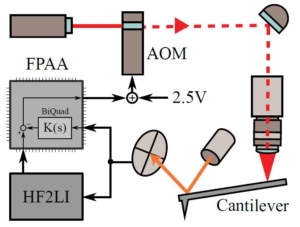 | M. G. Ruppert; B. S. Routley; A. J. Fleming; Y. K. Yong; G. E. Fantner Model-based Q Factor Control for Photothermally Excited Microcantilevers Proceedings Article In: Int. Conference on Manipulation, Automation and Robotics at Small Scales (MARSS), Helsinki, Finland, 2019, ISSN: 978-1-7281-0948-0. Abstract | Links | BibTeX | Tags: AFM, Multifrequency AFM, Sensors, Smart Structures, SPM, Vibration Control @inproceedings{Ruppert2019,Photothermal excitation of the cantilever for dynamic atomic force microscopy (AFM) modes is an attractive actuation method as it provides clean cantilever actuation leading to well-defined frequency responses. Unlike conventional piezo-acoustic excitation of the cantilever, it allows for model-based quality (Q) factor control in order to increase the cantilever tracking bandwidth for tapping-mode AFM or to reduce resonant ringing for high-speed photothermal offresonance tapping (PORT) in ambient conditions. In this work, we present system identification, controller design and experimental results on controlling the Q factor of a photothermally driven cantilever. The work is expected to lay the groundwork for future implementations for high-speed PORT imaging in ambient conditions. |
2018 |
||
| 20. |  | M. G. Ruppert Self-sensing, estimation and control in multifrequency Atomic Force Microscopy. Journal Article In: Journal & Proceedings of the Royal Society of New South Wales, vol. 151, no. 1, pp. 111, 2018, ISSN: 0035-9173/18/010111-01. Abstract | Links | BibTeX | Tags: Cantilever, MEMS, Multifrequency AFM, Sensors, Smart Structures, SPM, System Identification, Vibration Control @article{Ruppert2018b,Despite the undeniable success of the atomic force microscope (AFM), dynamic techniques still face limitations in terms of spatial resolution, imaging speed and high cost of acquisition. In order to expand the capabilities of the instrument, it was realized that the information about the nano-mechanical properties of a sample are encoded over a range of frequencies and the excitation and detection of higher-order eigenmodes of the micro-cantilever open up further informa- tion channels. The ability to control these modes and their fast responses to excitation is believed to be the key to unravelling the true potential of these ethods. This work addresses three major drawbacks of the standard AFM setup, which limit the feasibility of multi-frequency approaches. First, microelectromechanical system (MEMS) probes with integrated piezoelectric layers is motivated, enabling the development of novel multimode self-sensing and self-actuating techniques. Specifically, these piezoelectric transduction schemes permit the miniaturization of the entire AFM towards a cost-effective single-chip device with nanoscale precision in a much smaller form factor than that of conventional macroscale instruments. Second, the integrated actuation enables the development of multimode controllers which exhibits remarkable performance in arbitrarily modifying the quality factor of multiple eigenmodes and comes with inherent stability robustness. The experimental results demonstrate improved imaging stability, higher scan speeds and adjustable contrast when mapping nano-mechanical properties of soft samples. Last, in light of the demand for constantly increasing imaging speeds while providing multi-frequency flexibility, the estimation of multiple components of the high-frequency deflection signal is performed with a linear time-varying multi-frequency Kalman filter. The chosen representation allows for an efficient high-bandwidth implementation on a Field Programmable Gate Array. Tracking bandwidth, noise performance and trimodal AFM imaging on a two-component polymer sample are verified and shown to be superior to that of the commonly used lock-in amplifier. |
| 19. | 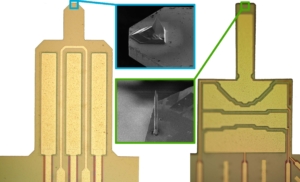 | M. G. Ruppert; S. I. Moore; M. Zawierta; G. Putrino; Y. K. Yong Advanced Sensing and Control with Active Cantilevers for Multimodal Atomic Force Microscopy Conference 7th Multifrequency AFM Conference, Madrid, Spain, 2018. Abstract | BibTeX | Tags: AFM, Cantilever, MEMS, Multifrequency AFM, Sensors, Smart Structures, SPM, Vibration Control @conference{Ruppert2018,Atomic force microscopy (AFM) cantilevers with integrated actuation and sensing on the chip level provide several distinct advantages over conventional cantilever instrumentation. These include clean frequency responses, the possibility of down-scaling and parallelization to cantilever arrays as well as the absence of optical interferences. While cantilever microfabrication technology has continuously advanced over the years, the overall design has remained largely unchanged; a passive rectangular shaped cantilever design has been adopted as the industry wide standard. Consequently, conventional cantilever instrumentation requires external piezo acoustic excitation as well as an external optical deflection sensor. Both of these components are not optimal for current trends in multifrequency AFM technology which revolve around further down-sizing, parallelization and measurements at multiple higher eigenmodes. Using microelectromechanical systems (MEMS) fabrication processes, this work aims to optimize cantilever instrumentation by realizing a new class of probes with high-performance integrated actuators and sensors. Equipped with multiple integrated piezoelectric layers for both actuation and sensing, these cantilevers are capable of achieving an increased higher eigenmode sensitivity and/or guaranteed collocated system properties compared to commercially available counterparts; examples of such designs are shown in Figure 1. The geometry as well as the integrated actuator/sensor arrangement is optimized using finite element modelling with individual design goals. The designs are realized using a commercial MEMS fabrication process and only require a simple five-mask patterning and etching process and post-fabricated sharp tips. |
2017 |
||
| 18. | 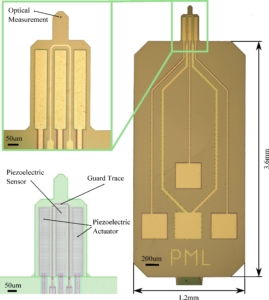 | M. G. Ruppert; Y. K. Yong Note: Guaranteed collocated multimode control of an atomic force microscope cantilever using on-chip piezoelectric actuation and sensing Journal Article In: Review of Scientific Instruments, vol. 88, no. 086109, 2017. Abstract | Links | BibTeX | Tags: AFM, Cantilever, MEMS, Multifrequency AFM, Piezoelectric Transducers and Drives, System Identification, Vibration Control @article{Ruppert2017b,The quality (Q) factor is an important parameter of the resonance of the microcantilever as it determines both imaging bandwidth and force sensitivity. The ability to control the Q factor of multiple modes is believed to be of great benefit for atomic force microscopy techniques involving multiple eigenmodes. In this paper, we propose a novel cantilever design employing multiple piezoelectric transducers which are used for separated actuation and sensing, leading to guaranteed collocation of the first eight eigenmodes up to 3 MHz. The design minimizes the feedthrough usually observed with these systems by incorporating a guard trace on the cantilever chip. As a result, a multimode Q controller is demonstrated to be able to modify the quality factor of the first two eigenmodes over up to four orders of magnitude without sacrificing robust stability. |
| 17. |  | M. G. Ruppert; M. Maroufi; A. Bazaei; S. O. R. Moheimani Kalman Filter Enabled High-Speed Control of a MEMS Nanopositioner Proceedings Article In: 20th IFAC World Congress, pp. 15554-15560, 2017. Abstract | BibTeX | Tags: MEMS, Nanopositioning, Tracking Control, Vibration Control @inproceedings{Ruppert2017b,We demonstrate a novel tracking controller formulation based on a linear time-varying Kalman Filter to regulate amplitude and phase of a reference signal independently. The method is applicable to sinusoidal references such as spiral, cycloid and Lissajous trajectories which are commonly used for imaging in high-speed Atomic Force Microscopy (AFM). A Microelectromechanical Systems (MEMS) based nanopositioner, whose fundamental resonance frequency is dampened with an additional damping feedback loop, is employed. For a scan range of 2um, we demonstrate experimental tracking of sinusoids with frequencies as high as 5kHz, well beyond the open-loop fundamental resonance, with a tracking error of only 4.6nm. |
2016 |
||
| 16. | 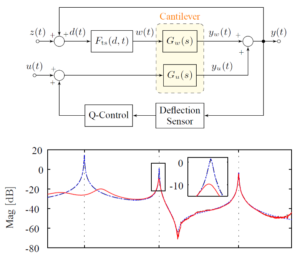 | M. G. Ruppert; S. O. R. Moheimani Multimode Q Control in Tapping-Mode AFM: Enabling Imaging on Higher Flexural Eigenmodes Journal Article In: IEEE Transactions on Control Systems Technology, vol. 24, no. 4, pp. 1149-1159, 2016. Abstract | Links | BibTeX | Tags: MEMS, Multifrequency AFM, SPM, System Identification, Vibration Control @article{Ruppert2016b,Numerous dynamic Atomic Force Microscopy (AFM) methods have appeared in recent years, which make use of the excitation and detection of higher order eigenmodes of the microcantilever. The ability to control these modes and their responses to excitation is believed to be the key to unraveling the true potential of these methods. In this work, we highlight a multi-mode Q control method that exhibits remarkable damping performance and stability robustness. The experimental results obtained in ambient conditions demonstrate improved imaging stability by damping non-driven resonant modes when scanning is performed at a higher eigenmode of the cantilever. Higher scan speeds are shown to result from a decrease in transient response time. |
| 15. | 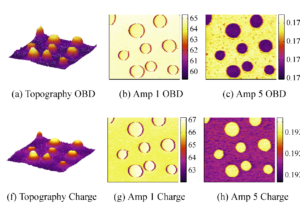 | M. G. Ruppert; S. O. R. Moheimani High-bandwidth Multimode Self-sensing in Bimodal Atomic Force Microscopy Journal Article In: Beilstein Journal of Nanotechnology, vol. 7, pp. 284-295, 2016. Abstract | Links | BibTeX | Tags: MEMS, Multifrequency AFM, Piezoelectric Transducers and Drives, Vibration Control @article{Ruppert2016b,Using standard microelectromechanical system (MEMS) processes to coat a microcantilever with a piezoelectric layer results in a versatile transducer with inherent self-sensing capabilities. For applications in multifrequency atomic force microscopy (MF-AFM), we illustrate that a single piezoelectric layer can be simultaneously used for multimode excitation and detection of the cantilever deflection. This is achieved by a charge sensor with a bandwidth of 10 MHz and dual feedthrough cancellation to recover the resonant modes that are heavily buried in feedthrough originating from the piezoelectric capacitance. The setup enables the omission of the commonly used piezoelectric stack actuator and optical beam deflection sensor, alleviating limitations due to distorted frequency responses and instrumentation cost, respectively. The proposed method benefits from a more than two orders of magnitude increase in deflection to strain sensitivity on the fifth eigenmode leading to a remarkable signal-to-noise ratio. Experimental results using bimodal AFM imaging on a two component polymer sample validate that the self-sensing scheme can therefore be used to provide both the feedback signal, for topography imaging on the fundamental mode, and phase imaging on the higher eigenmode. |
| 14. | 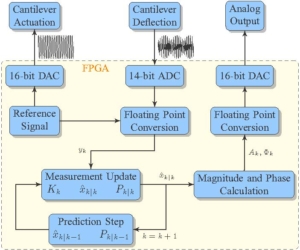 | M. G. Ruppert; K. S. Karvinen; S. L. Wiggins; S. O. R. Moheimani A Kalman Filter for Amplitude Estimation in High-Speed Dynamic Mode Atomic Force Microscopy Journal Article In: IEEE Transactions on Control Systems Technology, vol. 24, no. 1, pp. 276-284, 2016. Abstract | Links | BibTeX | Tags: Multifrequency AFM, SPM, Vibration Control @article{Ruppert2016b,A fundamental challenge in dynamic mode atomic force microscopy (AFM) is the estimation of the cantilever oscillation amplitude from the deflection signal which might be distorted by noise and/or high-frequency components. When the cantilever is excited at resonance, its deflection is typically obtained via narrowband demodulation using a lock-in amplifier. However, the bandwidth of this measurement technique is ultimately bounded by the low-pass filter which must be employed after demodulation to attenuate the component at twice the carrier frequency. Furthermore, to measure the amplitude of multiple frequency components such as higher eigenmodes and/or higher harmonics in multifrequency AFM, multiple lock-in amplifiers must be employed. In this work, the authors propose the estimation of amplitude and phase using a linear time-varying Kalman filter which is easily extended to multiple frequencies. Experimental results are obtained using square-modulated sine waves and closed-loop AFM scans, verifying the performance of the proposed Kalman filter. |
2015 |
||
| 13. | 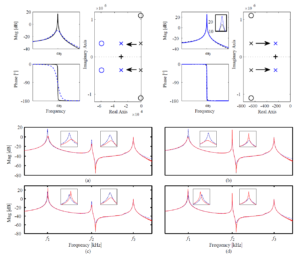 | M. G. Ruppert; S. O. R. Moheimani Multi-Mode Q Control in Multifrequency Atomic Force Microscopy Proceedings Article In: ASME International Design Engineering Technical Conferences & Computers and Information in Engineering Conference, pp. V004T09A009, Boston, Massachusetts, USA, 2015. Abstract | Links | BibTeX | Tags: MEMS, Multifrequency AFM, SPM, Vibration Control @inproceedings{Ruppert2015,Various Atomic Force Microscopy (AFM) modes have emerged which rely on the excitation and detection of multiple eigenmodes of the microcantilever. The conventional control loops employed in multifrequency AFM (MF-AFM) such as bimodal imaging where the fundamental mode is used to map the topography and a higher eigenmode is used to map sample material properties only focus on maintaining low bandwidth signals such as amplitude and/ or frequency shift. However, the ability to perform additional high bandwidth control of the quality (Q) factor of the participating modes is believed to be imperative to unfolding the full potential of these methods. This can be achieved by employing a multi-mode Q control approach utilizing positive position feedback. The controller exhibits remarkable performance in arbitrarily modifying the Q factor of multiple eigenmodes as well as guaranteed stability properties when used on flexible structures with collocated actuators and sensors. A controller design method based on pole placement optimization is proposed for setting an arbitrary on-resonance Q factor of the participating eigenmodes. Experimental results using bimodal AFM imaging on a two component polymer sample are presented. |
2013 |
||
| 12. | 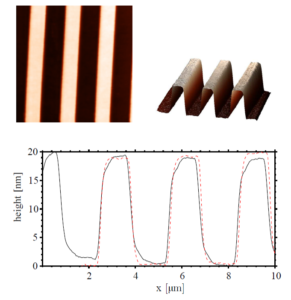 | M. G. Ruppert; M. Fairbairn; S. O. R. Moheimani Multi-Mode Resonant Control of a Microcantilever for Atomic Force Microscopy Proceedings Article In: IEEE/ASME International Conference on Advanced Intelligent Mechatronics, pp. 77-82, Wollongong, Australia, 2013. Abstract | Links | BibTeX | Tags: MEMS, Multifrequency AFM, Vibration Control @inproceedings{Ruppert2013,When operating the Atomic Force Microscope in tapping mode it is possible to decrease the quality factor of the microcantilever to enhance scan speed. %Standard Q Control techniques involve velocity feedback with the disadvantage of additional sensor equipment, or time-delay position feedback which may lead to instabilities of out-of-bandwidth modes.Various resonance controllers have been proposed which do not rely on expensive velocity sensors and guarantee stability of the closed loop system even in the presence of unmodeled dynamics. A new field of Atomic Force Microscopy is evolving, which makes use of multiple frequency excitation and detection of the cantilever modes making it necessary to be able to control these modes and their response to excitation. This work proposes a multi-mode Q control approach utilizing positive position feedback, offering full control over the first two flexural modes of the cantilever. By completely damping the first mode and adjusting the quality factor of the second mode, it is possible to scan and obtain images at the second resonance frequency which improves image quality at high scan speeds due to the increased bandwidth of the z-axis feedback loop. |
2009 |
||
| 11. | Y. K. Yong; S. O. R. Moheimani Vibration control of a novel tube scanner using piezoelectric strain-induced voltage Proceedings Article In: Proc. IEEE/ASME International Conference on Advanced Intelligent Mechatronics , 2009. Links | BibTeX | Tags: Nanopositioning, Sensors, Vibration Control @inproceedings{Yong20091070, | |
2006 |
||
| 10. | A. J. Fleming; S. Behrens; S. O. R. Moheimani Inertial vibration control using a shunted electromagnetic transducer Journal Article In: IEEE/ASME Transactions on Mechatronics, vol. 11, no. 1, pp. 84–92, 2006. Links | BibTeX | Tags: Vibration Control @article{J06a, | |
| 9. | D. Niederberger; S. Behrens; A. J. Fleming; S. O. R. Moheimani; M. Morari Adaptive electromagnetic shunt damping Journal Article In: IEEE/ASME Transactions on Mechatronics, vol. 11, no. 1, pp. 103–108, 2006. Links | BibTeX | Tags: Vibration Control @article{J06c, | |
2005 |
||
| 8. | A. J. Fleming; S. Behrens; S. O. R. Moheimani Synthesis and implementation of sensor-less active shunt controllers for electromagnetically actuated systems Journal Article In: IEEE Transactions on Control Systems Technology, vol. 13, no. 2, pp. 246–261, 2005. Links | BibTeX | Tags: Vibration Control @article{J05a, | |
| 7. | S. Behrens; A. J. Fleming; S. O. R. Moheimani Passive vibration control via electromagnetic shunt damping Journal Article In: IEEE/ASME Transactions on Mechatronics, vol. 10, no. 1, pp. 118–122, 2005. Links | BibTeX | Tags: Vibration Control @article{J05b, | |
| 6. | A. J. Fleming; S. O. R. Moheimani Proof-mass inertial vibration control using a shunted electromagnetic transducer Proceedings Article In: Proc. IFAC World Congress, Prague, Czech Republic, 2005. Links | BibTeX | Tags: Vibration Control @inproceedings{C05a, | |
2004 |
||
| 5. | S. Behrens; A. J. Fleming; S. O. R. Moheimani Vibration isolation using a shunted electromagnetic transducer Proceedings Article In: Proc. SPIE Symposium on Smart Structures & Materials -- Damping and Isolation, San Diego, CA, 2004. Links | BibTeX | Tags: Vibration Control @inproceedings{D04a, | |
| 4. | S. Behrens; A. J. Fleming; S. O. R. Moheimani Control orientated synthesis of electromagnetic shunt impedances for vibration isolation Proceedings Article In: Proc. IFAC Symposium on Mechatronic Systems, Sydney, Australia, 2004. Links | BibTeX | Tags: Vibration Control @inproceedings{C04d, | |
2003 |
||
| 3. | S. Behrens; A. J. Fleming; S. O. R. Moheimani Electromagnetic shunt damping Proceedings Article In: Proc. IEEE/ASME Confernece on Advanced Intelligent Mechatronics, Kobe, Japan, 2003. Links | BibTeX | Tags: Vibration Control @inproceedings{C03b, | |
| 2. | S. Behrens; A. J. Fleming; S. O. R. Moheimani Electrodynamic vibration suppression Proceedings Article In: Proc. SPIE Symposium on Smart Structures & Materials -- Damping and Isolation, San Diego, CA, 2003. Links | BibTeX | Tags: Vibration Control @inproceedings{D03d, | |
| 1. | A. J. Fleming; S. O. R. Moheimani Active H₂ and H[subscript infinity] shunt control of electromagnetic transducers Proceedings Article In: Proc. IEEE Conference on Decision and Control, Maui, HI, 2003. Links | BibTeX | Tags: Vibration Control @inproceedings{C03a, | |
2020 |
||
| 24. |  | AFM Cantilever Design for Multimode Q Control: Arbitrary Placement of Higher-Order Modes Journal Article In: IEEE/ASME Transactions on Mechatronics, pp. 1-6, 2020, (Early Access). |
2019 |
||
| 23. |  | Dynamics and Control of Active Microcantilevers Book Chapter In: Baillieul, John; Samad, Tariq (Ed.): Encyclopedia of Systems and Control, vol. 2, Springer London, 2019, ISBN: 978-1-4471-5102-9. |
| 22. |  | Multivariable Model-less Feedforward Control of a Monolithic Nanopositioning Stage With FIR Filter Inversion Proceedings Article In: International Conference on Manipulation, Automation and Robotics at Small Scales (MARSS), Helsinki, Finland, 2019, ISSN: 978-1-7281-0948-0. |
| 21. |  | Model-based Q Factor Control for Photothermally Excited Microcantilevers Proceedings Article In: Int. Conference on Manipulation, Automation and Robotics at Small Scales (MARSS), Helsinki, Finland, 2019, ISSN: 978-1-7281-0948-0. |
2018 |
||
| 20. |  | Self-sensing, estimation and control in multifrequency Atomic Force Microscopy. Journal Article In: Journal & Proceedings of the Royal Society of New South Wales, vol. 151, no. 1, pp. 111, 2018, ISSN: 0035-9173/18/010111-01. |
| 19. |  | Advanced Sensing and Control with Active Cantilevers for Multimodal Atomic Force Microscopy Conference 7th Multifrequency AFM Conference, Madrid, Spain, 2018. |
2017 |
||
| 18. |  | Note: Guaranteed collocated multimode control of an atomic force microscope cantilever using on-chip piezoelectric actuation and sensing Journal Article In: Review of Scientific Instruments, vol. 88, no. 086109, 2017. |
| 17. |  | Kalman Filter Enabled High-Speed Control of a MEMS Nanopositioner Proceedings Article In: 20th IFAC World Congress, pp. 15554-15560, 2017. |
2016 |
||
| 16. |  | Multimode Q Control in Tapping-Mode AFM: Enabling Imaging on Higher Flexural Eigenmodes Journal Article In: IEEE Transactions on Control Systems Technology, vol. 24, no. 4, pp. 1149-1159, 2016. |
| 15. |  | High-bandwidth Multimode Self-sensing in Bimodal Atomic Force Microscopy Journal Article In: Beilstein Journal of Nanotechnology, vol. 7, pp. 284-295, 2016. |
| 14. |  | A Kalman Filter for Amplitude Estimation in High-Speed Dynamic Mode Atomic Force Microscopy Journal Article In: IEEE Transactions on Control Systems Technology, vol. 24, no. 1, pp. 276-284, 2016. |
2015 |
||
| 13. |  | Multi-Mode Q Control in Multifrequency Atomic Force Microscopy Proceedings Article In: ASME International Design Engineering Technical Conferences & Computers and Information in Engineering Conference, pp. V004T09A009, Boston, Massachusetts, USA, 2015. |
2013 |
||
| 12. |  | Multi-Mode Resonant Control of a Microcantilever for Atomic Force Microscopy Proceedings Article In: IEEE/ASME International Conference on Advanced Intelligent Mechatronics, pp. 77-82, Wollongong, Australia, 2013. |
2009 |
||
| 11. | Vibration control of a novel tube scanner using piezoelectric strain-induced voltage Proceedings Article In: Proc. IEEE/ASME International Conference on Advanced Intelligent Mechatronics , 2009. | |
2006 |
||
| 10. | Inertial vibration control using a shunted electromagnetic transducer Journal Article In: IEEE/ASME Transactions on Mechatronics, vol. 11, no. 1, pp. 84–92, 2006. | |
| 9. | Adaptive electromagnetic shunt damping Journal Article In: IEEE/ASME Transactions on Mechatronics, vol. 11, no. 1, pp. 103–108, 2006. | |
2005 |
||
| 8. | Synthesis and implementation of sensor-less active shunt controllers for electromagnetically actuated systems Journal Article In: IEEE Transactions on Control Systems Technology, vol. 13, no. 2, pp. 246–261, 2005. | |
| 7. | Passive vibration control via electromagnetic shunt damping Journal Article In: IEEE/ASME Transactions on Mechatronics, vol. 10, no. 1, pp. 118–122, 2005. | |
| 6. | Proof-mass inertial vibration control using a shunted electromagnetic transducer Proceedings Article In: Proc. IFAC World Congress, Prague, Czech Republic, 2005. | |
2004 |
||
| 5. | Vibration isolation using a shunted electromagnetic transducer Proceedings Article In: Proc. SPIE Symposium on Smart Structures & Materials -- Damping and Isolation, San Diego, CA, 2004. | |
| 4. | Control orientated synthesis of electromagnetic shunt impedances for vibration isolation Proceedings Article In: Proc. IFAC Symposium on Mechatronic Systems, Sydney, Australia, 2004. | |
2003 |
||
| 3. | Electromagnetic shunt damping Proceedings Article In: Proc. IEEE/ASME Confernece on Advanced Intelligent Mechatronics, Kobe, Japan, 2003. | |
| 2. | Electrodynamic vibration suppression Proceedings Article In: Proc. SPIE Symposium on Smart Structures & Materials -- Damping and Isolation, San Diego, CA, 2003. | |
| 1. | Active H₂ and H[subscript infinity] shunt control of electromagnetic transducers Proceedings Article In: Proc. IEEE Conference on Decision and Control, Maui, HI, 2003. | |
